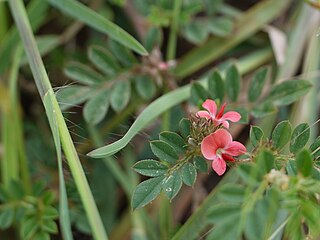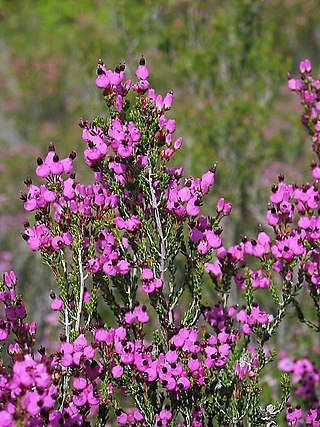
Geoffrey V, called the Handsome, the Fair or Plantagenet, was the Count of Anjou, Touraine and Maine by inheritance from 1129, and also Duke of Normandy by his marriage claim, and conquest, from 1144.

Genista is a genus of flowering plants in the legume family Fabaceae, native to open habitats such as moorland and pasture in Europe and western Asia. They include species commonly called broom, though the term may also refer to other genera, including Cytisus and Chamaecytisus. Brooms in other genera are sometimes considered synonymous with Genista: Echinospartum, Retama, Spartium, Stauracanthus, and Ulex.

Cytisus scoparius, the common broom or Scotch broom, is a deciduous leguminous shrub native to western and central Europe. In Britain and Ireland, the standard name is broom; this name is also used for other members of the Genisteae tribe, such as French broom or Spanish broom; and the term common broom is sometimes used for clarification. In other English-speaking countries, the most common name is "Scotch broom" ; however, it is known as English broom in Australia.

Genista monspessulana, commonly known as French broom, Montpellier broom, or Cape broom (Australia), is a woody leguminous perennial shrub. The yellow-flowering bush is native to the Mediterranean region, and while it may still be commonly sold in some garden stores, it is considered an invasive plant in most places where it has been introduced. It is a noxious weed on the western coast of the US and in parts of Australia.

Acacia colei is a perennial bush or tree native to northern Australia. A common name for it is Cole's wattle. Acacia colei blooms from May through September and the flowers are bright yellow.

Genista canariensis is a species of flowering plant in the legume family Fabaceae, known by the common names Canary broom, Canary Islands broom or florist's genista. It is native to the Canary Islands, but it grows as an introduced species in mainland Europe, especially Spain, and on other continents. It has been introduced to California and Washington State in the US. This is a vigorous upright evergreen shrub growing to 3 m (9.8 ft) tall by 1.5 m (4.9 ft) broad, with hairy green stems. The leaves are made up of oval-shaped blue-green leaflets each up to a centimeter long and densely hairy on the undersides. The raceme inflorescence holds up to 20 bright yellow pea-like flowers. The fruit is a legume pod one to two centimeters long containing several dark brown seeds.

Genista linifolia is a species of broom known by the common names Mediterranean broom, needle-leaved broom and flax broom. It is native to southwestern Europe, North Africa, and the Canary Islands.

Fumaria muralis, known as common ramping-fumitory or wall fumitory, is a flowering herbaceous plant in the poppy family (Papaveraceae) native to western Europe and northwestern Africa.

Ribes canthariforme is a rare species of currant commonly known as the Moreno currant. It is characterized by pink to red flowers, a dense inflorescence, and a lack of nodal spines. A little-known endemic to the mountains of San Diego County, it is usually found growing the shade of massive boulders in the chaparral. Although the rarity and small numbers of this plant is a conservation concern, it is usually found in remote areas and is well hidden enough to be safe from most threats.
Petenaea cordata was first described in Elaeocarpaceae and later placed in Tiliaceae, but most authors have been uncertain about its familial affinities. It was considered a taxon incertae sedis in the Angiosperm Phylogeny Group classification. Molecular analyses based on a recent collection from Guatemala indicate a distant, weakly supported sister-group relationship to the African genus Gerrardina. As no obvious synapomorphies exist for Gerrardina and Petenaea, the new monogeneric family Petenaeaceae was proposed. The polymorphic order Huerteales now comprises four small families: Dipentodontaceae, Gerrardinaceae, Petenaeaceae and Tapisciaceae. Petenaea cordata is the only species in the genus Petenaea.

In heraldry, the royal badges of England comprise the heraldic badges that were used by the monarchs of the Kingdom of England.
Cistus grancanariae is a shrubby species of flowering plant in the family Cistaceae. It was described for the first time in 2008. It is endemic to a small area in the north of the island of Gran Canaria.

Genisteae is a tribe of trees, shrubs and herbaceous plants in the subfamily Faboideae of the family Fabaceae. It includes a number of well-known plants including broom, lupine (lupin), gorse and laburnum.

Acacia arcuatilis is a shrub belonging to the genus Acacia and the subgenus Juliflorae that is endemic to south western parts of Australia.

Indigofera linnaei, known as Birdsville indigo and nine-leaved indigo, is a species of leguminous shrub in the genus Indigofera. The genus name, Indigofera, is derived from Latin and means bearing/containing indigo, while linnaei derives from Linnaeus.
Vicia canescens is a species of legume in the vetch genus that is endemic to Lebanon.

Psittacanthus cucullaris is a species of mistletoe in the family Loranthaceae, and is native to Costa Rica, Bolivia, Colombia, Ecuador, French Guiana, Peru, Suriname, Venezuela and Brazil.

Erica umbellata is a species of plant in the heather family (Ericaceae) native to the western Iberian Peninsula and northwestern Maghreb.

Verbesina centroboyacana is a species of shrub in the family Asteraceae endemic to Colombia.

Genista florida is a species of flowering plant belonging to the family Fabaceae.
















